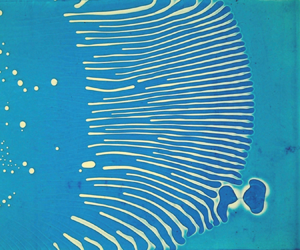Article contents
Fingering instability in adhesion fronts
Published online by Cambridge University Press: 06 October 2022
Abstract

The adhesion of two surfaces relies on the propagation of an adhesion front. What is the dynamics of the front when both surfaces are coated with a thin layer of viscous liquid? Standard criteria from fingering instabilities would predict a stable front since viscous fluid pushes away air of low viscosity. Surprisingly, the front propagation may be unstable and generally leads to growing fingers. We demonstrate with model experiments where the two adhering surfaces are slightly tilted by an angle  $\alpha$ that the origin of this interfacial instability relies on feeding the front from the surrounding thin film. We show experimentally that the typical wavelength of the instability is mainly dictated by the thickness of the oil layers
$\alpha$ that the origin of this interfacial instability relies on feeding the front from the surrounding thin film. We show experimentally that the typical wavelength of the instability is mainly dictated by the thickness of the oil layers  $h$. In this wedge geometry, the propagation dynamics is found to follow a
$h$. In this wedge geometry, the propagation dynamics is found to follow a  $t^{1/2}$ dependence and to saturate for an extension length of the order of
$t^{1/2}$ dependence and to saturate for an extension length of the order of  $h/\alpha$.
$h/\alpha$.
Information
- Type
- JFM Papers
- Information
- Copyright
- © The Author(s), 2022. Published by Cambridge University Press
References
- 3
- Cited by


